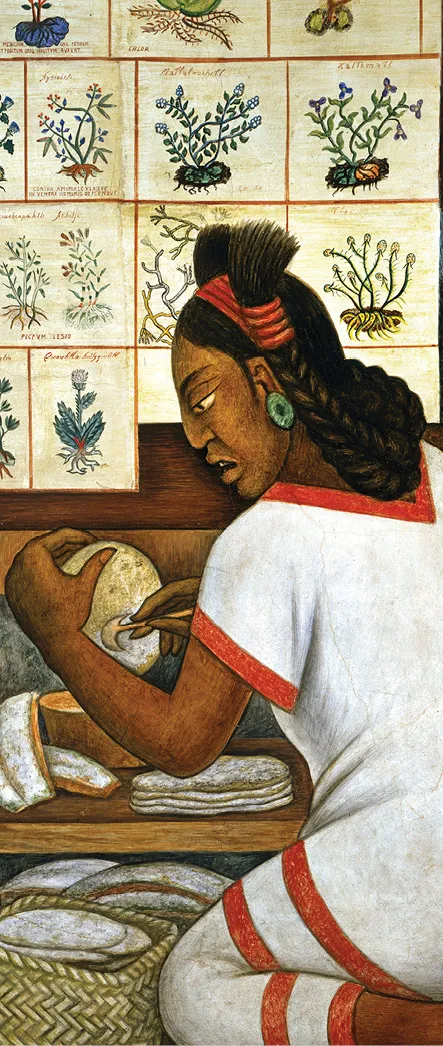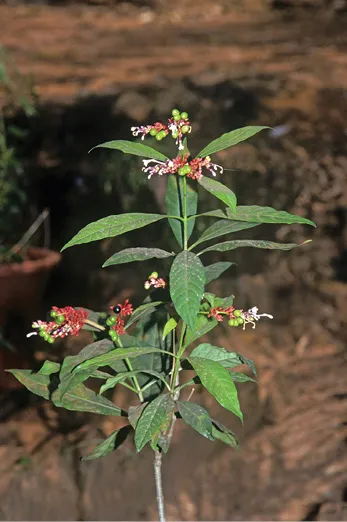1
People and Plants
Within sight of Mount Everest, between the Ganges River and the foothills of the Himalayas, grows a small climbing shrub with pinkish-white flowers, smooth leaves, and milky sap. Called in Hindi chota-chand, the shrub is rarely disturbed by the local people unless someone is bitten by a snake. The plant is then unearthed and a decoction of its long root given to the victim. A local legend claims that in ancient times, mongooses were observed to feed on the plant before engaging in combat with cobras. Copying the reputed activity of the mongoose, local people found that the shrub could serve as a potent antidote for snakebite.
Eighteenth-century botanists named the shrub Rauvolfia serpentina [Apocynaceae]. Rauvolfia, the name of the genus, honors the sixteenth-century explorer and botanist Leonard Rauwolf who introduced coffee to Europe; serpentina, the name of the species, describes the snakelike appearance of its root. Apocynaceae is the name of the family of plants that includes Rauvolfia serpentina.
In the eighteenth century, a specimen of this plant was sent to the herbarium, a museum-like repository of dried plants in Leyden, Holland, but Rauvolfia serpentina was then ignored by scientists, as most medicinal plants have been: fewer than ½ of 1% of all flowering plant species in the world have ever been exhaustively studied for their potential pharmacological activity.
But the plant was not forgotten by the local people, and its use spread to nearby cultures. In Bihar province, it was rumored that when a demented man had eaten slices of the root, he was cured of his madness. The people of Bihar began to use the plant to treat insanity, epilepsy, and insomnia, calling the shrub pagal-ka-dawa, “insanity cure.” They also found that a single dose of powdered roots could put a child into a deep sleep that lasted all night. Slowly the use of Rauvolfia serpentina to treat anxiety, insomnia, and madness spread throughout India.
In 1931, Indian chemists isolated a variety of molecules from the plant but found them to be relatively inactive. Their interest was renewed, however, by a report published in the Indian Medical Record that Rauvolfia powder not only had a hypnotic effect but also dramatically lowered blood pressure. Like many scientific reports published in developing countries, this discovery was unfortunately ignored by Western scientists. Then, in 1949, Emil Schlittler, a chemist at CIBA (Chemische Industrie Basel) Pharmaceuticals in Basel, Switzerland, read a clinical study of Rauvolfia by R. J. Vakil in the British Heart Journal. Schlittler, with his colleague Hans Schwarz, extracted from Rauvolfia roots an alkaloid, a nitrogen-containing physiologically active organic compound that they named reserpine. They demonstrated that a remarkably low oral dose of reserpine, 0.1 milligram per kilogram body weight, lowered blood pressure. In clinical tests, reserpine lowered one patient’s blood pressure from 300/150 to 160/100. American investigators confirmed these dramatic findings. “It has a type of sedative action that we have not observed before,” a Boston team reported to the New England Cardiovascular Society. “Unlike barbiturates or other standard sedatives, it does not produce grogginess, stupor, or lack of coordination.”
CIBA soon introduced reserpine to medicine under the trade name Serpasil. Up to that time, all known compounds that lowered blood pressure did so by dilating blood vessels. Reserpine, however, had a direct effect on the hypothalamus of the brain, opening up an entirely new mode of pharmacological action. In 1954, the New York Academy of Sciences sponsored a symposium devoted to the pharmaceutical importance of Rauvolfia. Reserpine became the first major drug to treat one of the most serious illnesses of the Western world: hypertension. More recently it has been prescribed in combination with other antihypertensive drugs, such as hydralazine hydrochloride.
How are we to characterize the discovery of reserpine? Does discovery of this important drug rest on “solid” science, such as structural chemistry and pharmacology, or is it attributable to folklore and legend? Laboratory scientists may hail the invention of reserpine as serendipitous, but one fact is inescapable: a plant used by indigenous peoples eventually became the source of one of the world’s most important pharmaceuticals.
There appears to be a wide gulf between folk knowledge and modern science, a gulf based on empirical verification. Science is the acquisition of knowledge based on careful observation and experimental tests of theory. Indigenous traditions are sometimes derided as steeped in superstition. Nevertheless, every time a Shipibo hunter fires a poison dart at an animal or a Tahitian healer administers a medicinal plant to a sick child, the efficacy of the indigenous tradition is empirically tested. Indigenous traditions and modern science are epistemologically closer to each other than Westerners might assume. The contexts of trials performed by Western scientists and by Shipibo hunters or Tahitian healers are obviously very different, but the empirical basis of both is clear: indigenous peoples use what works. The field of study that analyzes the results of indigenous manipulations of plant materials together with the cultural context in which the plants are used is called ethnobotany.
In broad terms, ethnobotany is the study of the relationship between plants and people. The two major parts of ethnobotany are encapsulated in the word itself: “ethno,” the study of people, and “botany,” the study of plants. Arrayed between these two points labeled “ethno” and “botany” lies a spectrum of interests ranging from archeological investigations of ancient civilizations to the bioengineering of new crops. However, the field is limited on both sides. On the botanical side of the field, few ethnobotanical studies are concerned with plants that have no connection to people. On the ethno side, most studies are concerned with the ways indigenous peoples use and view plants. And those uses and those views can provide deep insights into the human condition.
Much of ethnobotany deals with intellectual goals similar to those of cultural anthropology: to understand how other peoples view the world and their relation to it. The way people incorporate plants into their cultural traditions, religions, and even cosmologies reveals much about the people themselves. Some products of ethnobotanical research, such as the drug reserpine, transcend mere anthropological interest and are of profound medical importance to the West. People use plants in so many different ways that there are few arenas of human endeavor in which plants do not play an important role. Indeed, plants have determined the very course of civilization. In the thirteenth century, Marco Polo described an island “producing pepper, nutmegs, spikenard, galingale, cubebs, and all the precious spices that can be found in the world.” This report spurred a search for the Spice Islands, which inadvertently resulted in Europeans’ discovery of America and culminated in Magellan’s circumnavigation of the globe. Since the Renaissance, patterns of international trade in rubber, opium, and quinine have altered the fates of entire nations.
Even the plague of drug abuse that afflicts the world today can be considered an ethnobotanical problem, since it involves illicit traffic in substances—heroin, cocaine, hashish—that are derived from plants that indigenous peoples have used for centuries. In the economic sphere, few industrial societies can ignore the pivotal role of agriculture and forestry; indeed, much of the regulatory structure of the European Union governs trade in crops and other plants. A plethora of environmental crises—climate change, loss of biodiversity, tropical deforestation—...






